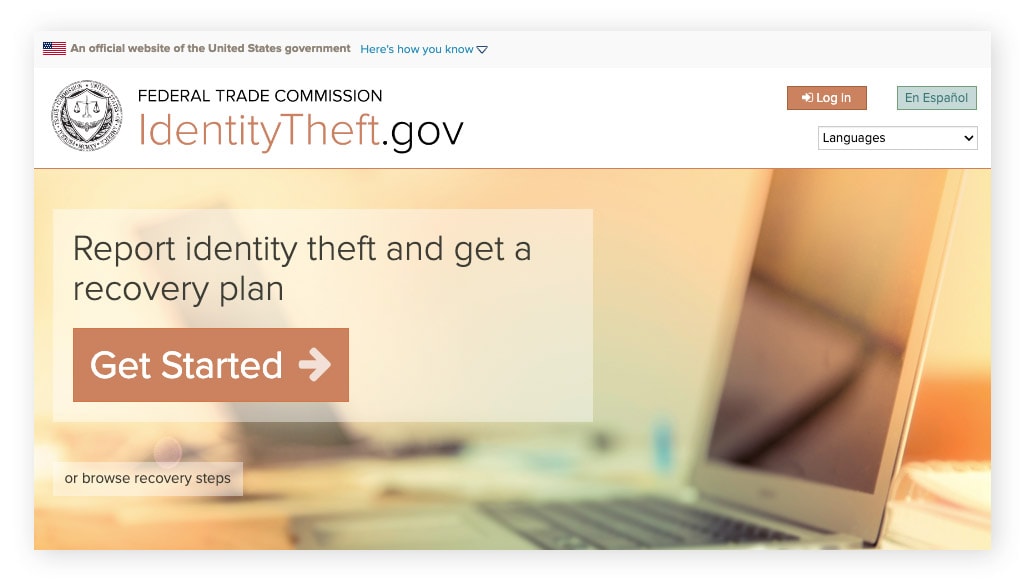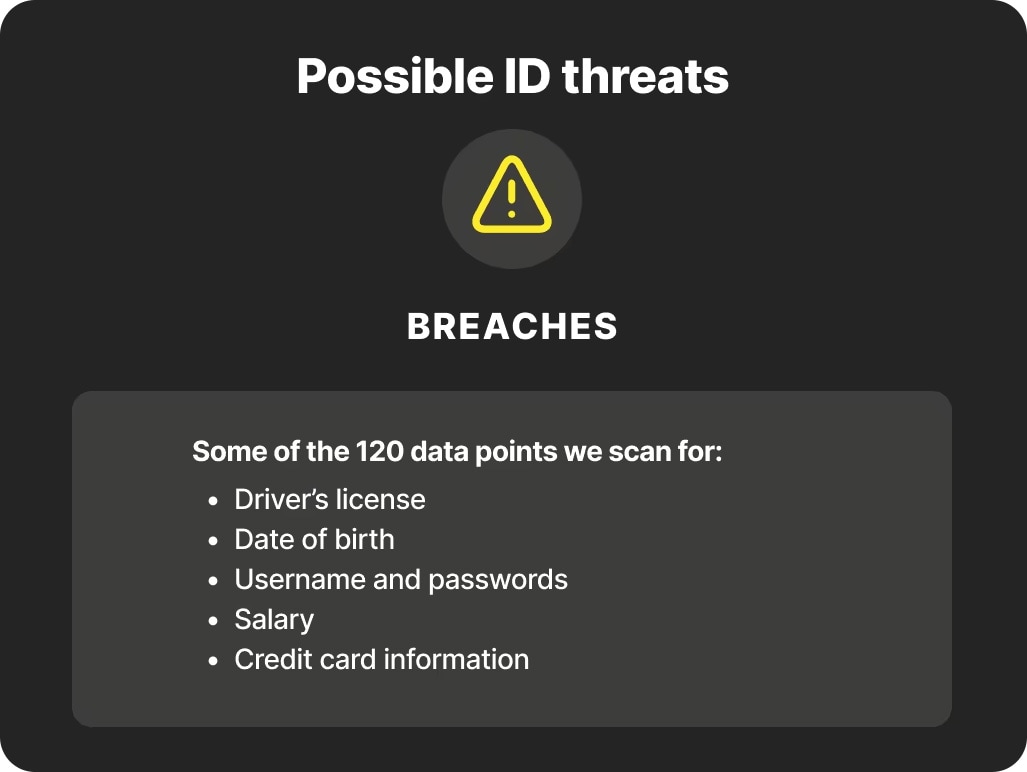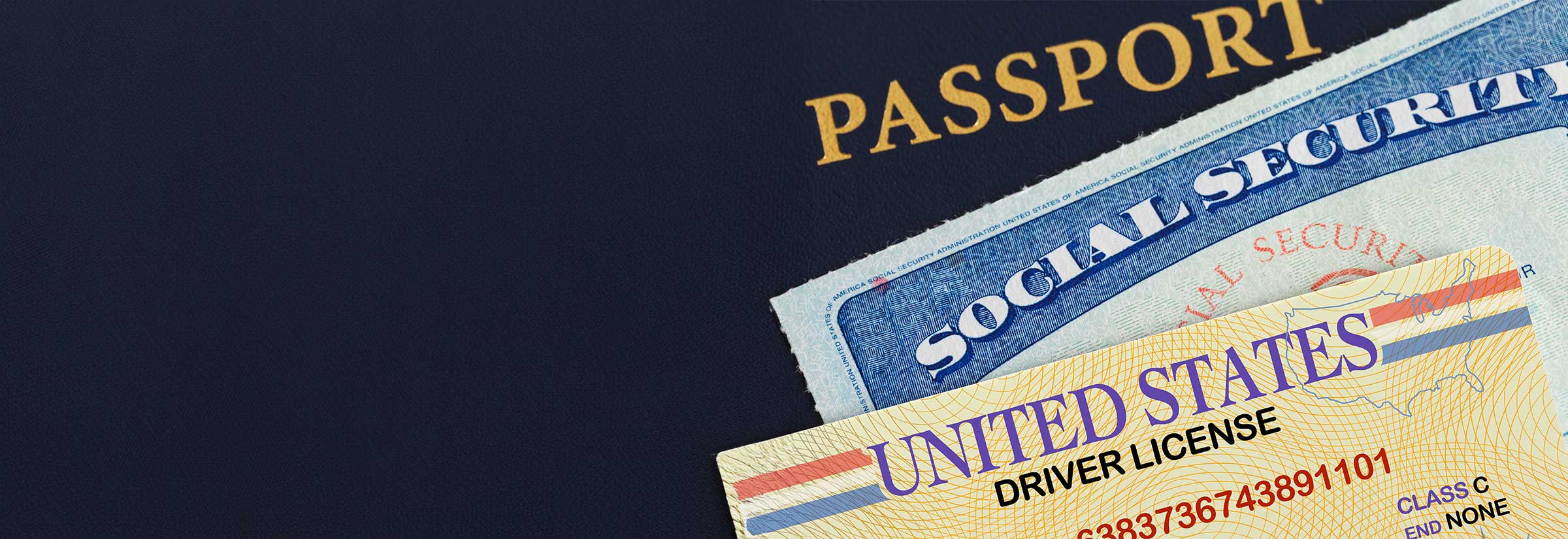Identity theft is easier than ever thanks to the amount of data people share online. All a criminal needs to impersonate you is access to personally identifiable information (PII), which includes your name, date of birth, address, and ID card number. In this article, we’ll review how someone can steal your identity with your ID and what to do if your ID gets stolen.
Can someone steal your identity with your ID?
Someone could steal your identity with your ID card, as possession of an ID card serves as proof of identity. A thief may also be able to use information from an ID like your driver's license or Social Security card to open a bank account or credit card in your name.
How a criminal can use your ID
A criminal can use your ID to steal your identity or alter the ID to create a new identity. The end goal is typically to commit financial fraud.
ID cards such as a driver’s license, passport, and Social Security card help prove who you are to financial and government organizations and legal authorities. This makes ID cards especially valuable to criminals.
Having your identity stolen can be much worse than just an inconvenience; it can lead to huge financial losses and ruined lives. In some cases, you may even mistakenly get into trouble with the law.
Lacking access to proof of identity can lead to nightmarish scenarios where others doubt your true identity. To cite an extreme example, a hospital worker in Iowa whose identity was stolen was himself accused of being the identity thief and spent more than 400 days in jail and almost 150 days in a mental hospital while the real ID thief roamed free until a private investigator uncovered the truth.
Knowing the signs of identity theft and taking immediate action if you spot it is imperative to maintaining peace of mind and minimizing the fallout. Here’s a closer look at what crooks can do if your ID falls into the wrong hands:

A criminal can use your ID to commit fraud.
Steal your identity
It can be easy for thieves to steal your identity using your ID. Even if they don’t resemble you physically, criminals can open fraudulent bank and credit card accounts online or over the phone—as long as they have enough of your details, that’s often sufficient.
Identity theft is no small matter of inconvenience. According to a recent Norton Cyber Safety Insights Report, in 2022 alone over $29 billion was stolen from identity theft victims, who reported an average loss of more than $2,000. That’s a substantial amount for the average American household, putting savings and other financial accounts at significant risk.
Sell your personal information on the dark web
Some ID thieves are less interested in using your information directly and, instead, sell it on the dark web where marketplaces for stolen identities and other illicit goods and services abound.
And identity theft can be an easy way to make some quick cash. Privacy Affairs’ Dark Web Price Index study found that personal information like online banking credentials cost an average of $100 while $1,000 can buy a full range of documents and account info.
Use your license to make fake IDs
Identity thieves can also use your driver’s license to make fake IDs. If someone has your driver’s license number they can use it to make a fake ID. Or, if they have your physical driver’s license, they can just copy it directly. Penalties for making fake IDs depend on the purpose of the forgery but can lead to hefty fines and even jail time.
Even if you’re not implicated in the creation of the fake ID, you can still get caught up in a mess if your real name and/or ID number is used on a fake ID and the impersonator gets arrested.
Commit fraud
A criminal could use your legal ID to commit fraud if they open an account or engage in contractual, financial, or other legal actions in your name.
IDs are commonly used for the following kinds of fraud:
- Mail fraud
- Military ID fraud
- Investment fraud
- Estate fraud
- Mortgage fraud
- Real estate fraud
- Tax fraud
- Credit card fraud
As with the fake ID scenario, the fraudulent use of your real ID to engage in criminal activities can implicate you if the criminal activity is uncovered. If fraud is committed in your name, you could get in legal trouble and be held liable for any financial losses. To avoid these sorts of issues, report a lost or stolen ID as soon as you realize it’s missing.
Create a synthetic identity
A criminal can also use your ID as the basis for a synthetic identity—a completely new identity created from both real and fake information—which can then be used to commit fraud. While some aspects of synthetic identity theft can be faked, such as a date of birth or current address, others, such as a Social Security number, cannot be easily faked.
If your Social Security number is used as a basis for a synthetic identity, this could cause major problems for you. For instance, if the fraudster opens a credit account, the bank may be able to track you down and try to get you to make repayments.
What to do if your ID is stolen: 11 tips
A stolen driver’s license or other ID can cause major problems if left unaddressed. If you know your ID has been stolen, you should act immediately. Here are the steps to take if your ID is stolen, in order of priority:
1. Contact your state’s ID issuing agency
Contact your state’s DMV or relevant ID issuing agency immediately to report your stolen ID. You can call during opening hours or go online anytime. The ID issuing agency will provide you with the necessary steps to replace your lost ID, which may include filling out a form, providing proof of identity, and paying a replacement fee.
You will likely need to provide your name, date of birth, address, your driver’s license or state ID card number, and Social Security number. You may also be asked to provide proof of fraud, such as a police report or FTC report.
2. Contact the police
Reporting the stolen ID to the police can help prevent you from being implicated in any criminal activity done in your name, and it can make things easier when applying for a new ID card.
Contact your local police precinct or visit in person to file a report. Besides basic personal information and alternative proof of identity, provide as many details as possible about how you lost your ID and how it has been used fraudulently, if applicable. The police will give you a copy of the report.
3. Set up a fraud alert on your credit report
Once you’ve reported the theft to the police, set up a fraud alert on your credit report by contacting one of the three credit bureaus. A fraud alert flags that your personal information has been or may be compromised.
A fraud alert means any credit application in your name won’t be able to move forward without further verification of your identity. This makes it much harder for criminals to open fraudulent accounts using your name.
To set up a fraud alert, go to any of the three credit bureaus’ websites and follow the instructions. If you don’t plan on taking out any new loans or credit cards soon, you can freeze your credit and lock out any fraudsters attempting to open accounts with your name.
4. Fill out a fraud report with the FTC
You should also report the identity theft to the FTC. Visit IdentityTheft.gov and follow the instructions to fill out a report.
While the FTC can’t help you find the fraudster, they can generate a personal recovery plan based on the information you fill out in your report. The FTC can also help you carry out that plan, including tracking progress and pre-filing forms and letters for you.

5. Reach out to the USPS to ensure there is no change of address
Criminals can use your ID to change your address, which can redirect important mail communication elsewhere. If you receive a Change-of-Address Validation Letter from the USPS but aren’t moving, you can go online and dispute the change-of-address order.
Once made aware of the issue, the USPS can cancel any change of address order in their system, and any further attempt to change your address will immediately be flagged.
6. Run a criminal background report on yourself
You can also run a criminal background report on yourself to check if someone is using your identity and if any crime has been committed in your name.
Start by visiting your local police station to request your criminal record—call ahead to check the process first as it varies by location. To dig deeper, you can request an Identity History Summary (rap sheet) from the FBI, for a fee. You can also request a driving record and run a credit check.
Once you’ve obtained each record, review them carefully and make note of any inaccuracies as these may be a sign of fraud.
7. Check your bank and credit card statements regularly
Sometimes criminals can commit fraud after gaining access to bank and credit card accounts linked to your ID. It’s good practice to check your bank and credit card statements regularly to make sure you recognize all charges.
If you see any suspicious charges on your accounts, contact your financial service provider immediately to dispute the charge and lock the criminal out of your account.
You can also request your credit report for free once a year, and if you find anything suspicious you should dispute the credit report. To protect yourself in the future, sign up for an ID theft protection or credit monitoring service to get automatic alerts to help identify suspicious activity or credit applications.
8. Make sure your Social Security statement is accurate
You can review your Social Security statement online for accuracy. Your Social Security statement shows your future benefits and earnings history. If any earnings are turning up that you don’t recognize, someone may be using your Social Security number for Social Security fraud, such as falsely claiming benefits.
If you see any strange information on your Social Security statement, you should contact the Social Security Administration immediately and report the discrepancy. You’ll be asked to provide information about your current employment and employment history, so make sure to have statements like pay stubs and W-2 forms ready.
9. Perform a dark web scan to see if your information is being sold
Performing a dark web scan can help you see if your information is being sold on the dark web. You can use a trusted cybersecurity tool like LifeLock’s dark web breach scanner—enter your email address and it will scan the dark web and display any of your info found.

10. Get a new ID
Of course, you’ll need to get a new ID to replace the stolen one. How you do it will depend on which ID was stolen—your driver’s license, Social Security card, passport, etc. Visit the US government website for information on how to replace vital documents.
11. Sign up for identity theft protection
To help reduce the risk of identity theft in the future, you can sign up for an identity theft protection service to help regularly monitor for ID theft and fraud, as well as provide assistance and insurance to cover certain costs if you fall victim to identity theft.
Choose a product like LifeLock Standard that monitors your credit and personal information found online, helping to protect against identity fraud. LifeLock will also provide insurance coverage and access to legal support should you fall victim to identity theft.
Help safeguard your identity
LifeLock Standard helps protect against identity theft by monitoring hundreds of millions of data points a second for your peace of mind and security. We’ll also let you know of address change requests at the U.S. Postal Service, in case identity thieves try to divert your mail to steal financial information.
LifeLock Standard includes additional benefits like stolen wallet protection, utility account creation monitoring, and access to US-based identity restoration specialists should you fall victim. Get peace of mind today with the leader in identity theft protection.
FAQs about having your ID stolen
Have more questions about having your identity stolen? We’ve got answers.
Is it safe to give out your ID number?
It’s only safe to share your ID number on official forms or if you initiated contact with an organization and they request it. Don’t hand over your ID number if you didn’t initiate communication, because identity thieves can pretend to be a bank or government agency to try and trick people into divulging personal details like ID numbers.
How common is identity theft?
Identity theft is all too common. There’s a new victim every three seconds and over 51 million U.S. consumers experienced identity theft over the past four years.**
Is it hard to come back from identity theft?
The longer the identity theft goes on without the situation being rectified, the harder it is to come back from it. It also depends on what info the thief holds. If you have identity theft protection that includes a restoration service, you’ll have an easier time getting back on your feet thanks to personalized, expert assistance.
Can someone steal my identity with my name and address?
Usually, someone can’t steal your identity with a name and address alone. However, they can use this information to look you up online and potentially access more personally identifiable information, such as your date of birth and phone number. They could then use social media or other sources to get what they need to steal your identity.
* Restrictions apply. Automatically renewing subscription required. If you are a victim of identity theft and not satisfied with our resolution, you may receive a refund for the current term of your subscription. See LifeLock.com/Guarantee for complete details. No one can prevent all cybercrime or prevent all identity theft.
** Based on cumulative figures from three online surveys of 16,014 total U.S. adults conducted by The Harris Poll in October 2018, January 2019, February 2021 and January 2023.
Editor’s note: Our articles provide educational information. LifeLock offerings may not cover or protect against every type of crime, fraud, or threat we write about.
Start your protection,
enroll in minutes.
LifeLock is part of Gen – a global company with a family of trusted brands.
Copyright © 2025 Gen Digital Inc. All rights reserved. Gen trademarks or registered trademarks are property of Gen Digital Inc. or its affiliates. Firefox is a trademark of Mozilla Foundation. Android, Google Chrome, Google Play and the Google Play logo are trademarks of Google, LLC. Mac, iPhone, iPad, Apple and the Apple logo are trademarks of Apple Inc., registered in the U.S. and other countries. App Store is a service mark of Apple Inc. Alexa and all related logos are trademarks of Amazon.com, Inc. or its affiliates. Microsoft and the Window logo are trademarks of Microsoft Corporation in the U.S. and other countries. The Android robot is reproduced or modified from work created and shared by Google and used according to terms described in the Creative Commons 3.0 Attribution License. Other names may be trademarks of their respective owners.





